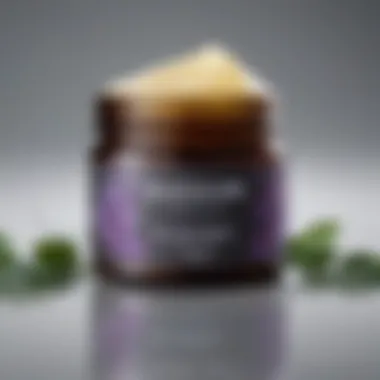Essential Oils for Rashes: Natural Healing Solutions


Intro
The topic of skin health is paramount for individuals across all ages, particularly when it comes to addressing rashes. Skin rashes can occur for numerous reasons, including allergies, infections, or irritants. Using essential oils as a natural remedy offers a potential pathway to alleviate discomfort and promote healing.
This guide delves into the properties of various essential oils that may effectively combat inflammation and support skin restoration. Readers will gain insights into proper application methods, safety considerations, and the overall benefits of these natural substances. Understanding the risks associated with essential oils is equally important, as misuse can lead to adverse reactions. The goal of this article is to provide comprehensive knowledge that empowers readers to make informed decisions about their skin care routines.
Understanding Rashes
Rashes are not just skin complaints but significant indicators of health issues, requiring a thorough understanding. Knowing the different types of rashes helps in identifying their underlying causes and choosing the right treatment options. This article emphasizes the importance of recognizing rashes as they often signal an immune response or allergic reaction.
Definition of Rashes
A rash is defined as a noticeable change in the texture or color of the skin. It may appear as redness, bumps, or patches and can be localized or widespread. Rashes can cause discomfort or itching and are often symptomatic of an underlying condition. Understanding the definition of rashes sets the stage for effective treatment, particularly when exploring natural remedies like essential oils.
Types of Rashes
Different types of rashes manifest in various ways and have distinct causes. This variation is critical in determining effective treatment methods.
Contact dermatitis
Contact dermatitis occurs when the skin comes into direct contact with an irritant or allergen. This type is characterized by redness, swelling, and itching in the affected area. It is common and is a relevant topic as it can easily be treated with essential oils known for their calming properties. The unique aspect of contact dermatitis is its immediate response to irritants, making it crucial to identify the trigger for a proactive approach.
Eczema
Eczema, or atopic dermatitis, is a chronic condition characterized by dry, inflamed skin. It is often itchy and can worsen with triggers like stress or allergens. Understanding eczema is important because it demonstrates the role of skin hydration and anti-inflammatory measures in treatment. Essential oils can provide soothing relief, making them a beneficial component in managing eczema effectively.
Psoriasis
Psoriasis is an autoimmune condition marked by rapid skin cell production, leading to thick, red patches covered with scales. This condition is chronic and can be aggravated by stress or environment. Recognizing psoriasis is important in this article as it shows how essential oils can help reduce inflammation and provide relief. Its chronic nature necessitates regular management and can benefit from natural remedies that focus on skin health.
Allergic reactions
Allergic reactions produce rashes as a response to exposure to allergens such as food, pollen, or certain fabrics. These reactions can be immediate or delayed and often lead to significant discomfort. It is key to highlight allergic reactions because they illustrate the potential of essential oils in calming inflamed skin. The unique feature of these rashes is their varying delay after exposure, pinpointing the need for tailored approaches in treatment.
Common Causes of Rashes
Several factors contribute to the development of rashes. Understanding these causes helps in prevention and treatment strategies.
Allergens
Allergens are substances that trigger allergic reactions. They are significant as they can lead to various rashes, from mild to severe. Recognizing allergens is beneficial in this article as it allows individuals to avoid triggers and manage skin health effectively through essential oils and other natural remedies.
Irritants
Irritants include chemicals and substances that can damage the skin. Common irritants like soaps, detergents, or even sunlight can lead to rashes. Their distinctive characteristic in hastening rashes highlights the importance of gentle skin care. Prevention by avoiding known irritants can greatly benefit skin conditions, making essential oils a popular choice for soothing the skin.
Infections
Skin infections caused by bacteria, viruses, or fungi can lead to rashes. Understanding the infectious origins of rashes is crucial, as it determines the type of treatment required. Some essential oils possess antibacterial properties, making them suitable for certain cases of infections.
Skin conditions
Various skin conditions can lead to rashes, from acne to rosacea. Each condition has unique characteristics and treatment requirements. Recognizing these conditions is essential when considering the application of essential oils for their medicinal properties, providing a base for exploring natural solutions for skin healing.
The Role of Essential Oils in Skin Care
Essential oils have gained recognition for their various applications in skin care, particularly in the treatment of rashes. These naturally occurring aromatic compounds are extracted from plants and contain a mix of beneficial properties that can enhance skin health. In the context of treating rashes, it is important to understand how essential oils support healing and provide relief.
Essential oils can be an effective adjunct to conventional therapies. Their appeal lies in their ability to target specific symptoms associated with rashes. By utilizing these oils, individuals may find a more holistic approach to skin care. Furthermore, the growing trend of natural remedies makes essential oils a popular choice among those seeking alternatives to synthetic products.
What Are Essential Oils?


Essential oils are concentrated liquids that capture the natural fragrance and properties of plants. These oils have volatile compounds, which is why they are potent. Typically derived through distillation or cold pressing, essential oils vary in their chemical constituents and therapeutic benefits. Each oil is distinct, with its own set of properties that can aid in skincare. A few well-known examples include lavender oil, tea tree oil, and chamomile oil.
Due to their concentrated nature, it is crucial to use essential oils properly. Dilution is often needed to avoid skin irritation. Knowledge of each oil's characteristics helps in choosing the right one for specific rashes.
Benefits of Essential Oils for Skin
Essential oils offer numerous benefits for skin, particularly in the context of treating rashes. Among these benefits, anti-inflammatory properties, antimicrobial effects, and skin hydration stand out as critical aspects. Each of these makes essential oils a favored choice for addressing skin issues.
Anti-inflammatory properties
The anti-inflammatory properties of essential oils play a significant role in alleviating symptoms of rashes. This characteristic is essential for individuals suffering from inflammatory conditions like eczema or psoriasis. Essential oils such as lavender and chamomile have shown strong anti-inflammatory effects. These not only reduce redness and swelling but also promote a faster healing process. Their popularity stems from their efficacy in soothing irritated skin, which is often a primary concern for those with rashes. People appreciate this quality because it provides relief without relying solely on synthetic anti-inflammatory treatments.
Antimicrobial effects
Antimicrobial effects are another valuable aspect of essential oils. Many oils, including tea tree oil, are recognized for their ability to combat bacteria, fungi, and viruses. This quality is particularly beneficial for rashes that may be compromised by infections. The presence of these microorganisms can delay recovery and worsen conditions, making the antimicrobial feature crucial. Incorporating oils with such properties helps not only in reducing microbial load but also preventing secondary infections. Consequently, essential oils with antimicrobial effects often become the first choice for those wanting a natural option.
Skin hydration
Skin hydration is a fundamental requirement in any skin care regimen. Some essential oils, particularly those that have emollient properties, can enhance skin moisture levels effectively. For instance, oils like sweet almond and neroli assist in maintaining skin elasticity while soothing dry patches, which are typical in many rash scenarios. Proper hydration aids in the skin's natural repair process, making it easier for rashes to heal. This quality resonates with many users who seek moisturization alongside treatment, adding to the oils' wide appeal. Properly hydrating the skin often leads to improvements in overall skin health, providing further justification for their use in skincare routines.
"The use of essential oils in skin care can provide a safer alternative to traditional treatments, promoting both healing and comfort."
When considering essential oils for treating rashes, understanding their specific properties and benefits helps individuals make informed choices. Knowing how oils interact with the skin can empower users to explore these options further.
Essential Oils Beneficial for Rashes
Essential oils have gained attention in recent years for their potential benefits in treating skin conditions, including rashes. The topic of essential oils beneficial for rashes is significant as these natural remedies provide an alternative to conventional treatments. They can help soothe inflammation, reduce itching, and promote faster healing, thus being particularly important for those seeking natural care options. The unique properties of various essential oils enable them to target symptoms effectively while also addressing underlying skin issues.
Tea Tree Oil
Properties
Tea tree oil is renowned for its strong antibacterial and antifungal properties. This essential oil helps combat various microorganisms that can exacerbate rashes. Its high concentration of terpenes contributes to its effectiveness in reducing inflammation. The key characteristic of tea tree oil is its ability to penetrate the skin and start working on the affected area quickly. One unique feature is its versatility; it can be used for multiple skin issues, making it a popular choice in this guide.
Uses
The uses of tea tree oil in treating rashes are extensive. It can be applied topically to affected areas, diluted in a carrier oil to enhance absorption. Users appreciate its quick action in providing relief from itching and redness. However, it is also important to note that tea tree oil can cause irritation for some people, so caution is advised.
Safety concerns
Safety is a critical aspect when considering tea tree oil. Before using it on large skin areas, conducting a patch test is advisable. Some individuals may experience allergic reactions or skin sensitization. Thus, being aware of personal sensitivities is key to avoiding harmful effects.
Lavender Oil
Properties
Lavender oil is well-known for its calming fragrance and anti-inflammatory qualities. This oil helps in reducing redness and soothing irritated skin. The relaxing effects are a bonus, as many people find it helpful for stress relief, which can unknowingly exacerbate skin issues. Its unique feature lies in its gentle nature, making it suitable for sensitive skin types.
Uses
Lavender oil is commonly used in various ways to treat rashes. It can be added to baths or mixed into topical applications. Its dual ability to promote skin healing while also calming the mind makes it a beneficial inclusion in the realm of essential oils for rashes. However, individuals should be mindful of using pure lavender oil as mixes or adulterated oils may not carry the same effectiveness.
Safety concerns
When using lavender oil, safety considerations involve potential allergic reactions. It is necessary to follow dilution guidelines and perform patch testing before extensive use. Its generally safe profile is comforting, but individual responses can vary; monitoring is key.
Chamomile Oil
Properties
Chamomile oil is celebrated for its soothing properties, particularly for sensitive and inflamed skin. It contains antifungal and antibacterial characteristics that can assist with rash management. Its ability to calm the skin is attributed to its high chamazulene content, which reduces redness and swelling. This unique characteristic positions chamomile oil as a valuable player in essential oils for rashes.


Uses
Chamomile oil can be used in direct applications or diluted forms. It is commonly added to creams or lotions designed for problematic skin. Its gentle effectiveness makes it a sound choice for those with sensitive skin. Notably, despite its benefits, chamomile might trigger reactions in individuals allergic to plants in the daisy family, warranting caution.
Safety concerns
Safety concerns for chamomile oil relate mainly to potential allergies. People who are prone to allergies should approach its use with caution. Conducting patch tests is vital to ensure no adverse reactions occur, especially given its frequent use among various skin types.
Frankincense Oil
Properties
Frankincense oil is known for its potent anti-inflammatory properties. It promotes skin cell regeneration and aids healing of the skin. This oil contains boswellic acids, which contribute to its pain-relieving effects. The integrity of its properties supports the skin's natural regeneration processes, making it a valuable option in addressing rashes.
Uses
Users often incorporate frankincense oil in skin care routines aimed at reducing scarring and promoting even skin tone. It can be included in serums or mixed into face creams. Its anti-aging qualities also serve as an added advantage. However, the unique scent may not appeal to everyone, which can limit its use in certain applications.
Safety concerns
While frankincense oil is relatively safe, the potential for skin irritation exists, particularly for those with sensitive skin types. As always, carrying out a patch test prior to full application is advisable to avoid adverse reactions.
Neroli Oil
Properties
Neroli oil is celebrated for its ability to soothe and rejuvenate the skin. It possesses antibacterial and anti-inflammatory properties, making it effective for rashes. Its unique feature lies in its restorative effects on skin elasticity and overall appearance. Use of neroli oil not only addresses immediate rash concerns but enhances the overall health of the skin.
Uses
Users commonly utilize neroli oil by adding it to creams or lotions for a healing boost. It can also be used in aromatherapy to reduce stress, which is beneficial for those experiencing rashes due to stress-related skin conditions. However, neroli is one of the more expensive essential oils, which can be a drawback for daily use.
Safety concerns
Neroli oil is generally regarded as safe, but those with citrus allergies should exercise caution. Its potent concentration means that appropriate dilution is necessary to prevent skin reactions. Monitoring personal responses is crucial to ensure a safe experience when using neroli oil.
How to Use Essential Oils for Rashes
Essential oils present a holistic approach to treating rashes, allowing individuals to utilize nature's potent remedies. Understanding how to effectively use these oils can maximize their benefits and minimize risks. Primary considerations include dilution, application methods, and safety practices.
Dilution Guidelines
Dilution is crucial when using essential oils, especially for those with sensitive skin. Essential oils are highly concentrated, and applying them undiluted can lead to skin irritation or adverse reactions.
A common guideline suggests diluting essential oils in a carrier oil, such as coconut oil, jojoba oil, or almond oil. A typical dilution ratio is 2 to 3 drops of essential oil per teaspoon of carrier oil. This not only helps in reducing the potency but also ensures the skin absorbs the oil effectively. Moreover, some oils may require more caution, requiring further dilution.
Knowing how to properly dilute essential oils ensures that users can enjoy their benefits without facing negative side effects. This knowledge is fundamental in any discussion related to essential oils.
Application Methods
Direct application
Direct application is one of the simplest methods for using essential oils on rashes. This method involves applying a diluted essential oil mixture directly onto the affected area. One key characteristic of direct application is its immediacy. Users can feel relief almost instantly as the oil penetrates the skin.
However, caution is necessary. Using essential oils without proper dilution can cause skin burns or irritation. This risk underscores the importance of following dilution guidelines before using this method.
Incorporation in lotions
Incorporating essential oils into lotions is another popular option. This method allows individuals to blend the therapeutic properties of essential oils with the moisturizing effects of body lotions. A key benefit of this method is its ease of application and the ability to cover larger areas of skin.
Moreover, this approach provides a dual benefit; it hydrates the skin while delivering essential oil properties. However, essential oils should be thoroughly mixed to ensure consistent effectiveness, and care should be taken to select lotions free from irritating chemicals.


Diffusion
Diffusion is less direct yet serves a vital role in the context of overall skin health. While it may not directly apply essential oils to the skin, it disperses essential oil molecules into the air, promoting relaxation and reducing stress. Stress can often exacerbate skin conditions, including rashes.
The unique aspect of diffusion is its holistic nature. It not only provides potential benefits for the skin but can also enhance emotional well-being. However, relying solely on this method for rash treatment might not yield visible results, making it more suitable as a supplementary approach rather than a primary treatment strategy.
The method of application can deeply influence the effectiveness of essential oils on skin health. Proper usage ensures the best outcomes when dealing with rashes.
Safety Considerations with Essential Oils
When exploring the use of essential oils for treating rashes, it is crucial to emphasize safety considerations. Each essential oil possesses unique properties that can offer benefits, yet they can also cause adverse reactions if not handled with care. Understanding these elements is essential for ensuring that the application of essential oils is both effective and safe.
Patch Testing
Patch testing serves as a vital step in determining an individual's tolerance to specific essential oils. This process involves applying a diluted form of the oil to a small area of skin, typically on the inner forearm, and observing for any signs of irritation or allergic reaction over a period of 24 to 48 hours. Conducting this test allows one to ascertain possible sensitivities or allergies that could surface when the oil is used more broadly.
It is always wise to start with essential oils like tea tree or lavender, as they are renowned for their milder properties. If redness, itching, or swelling develops, it may indicate that the oil is not suitable for personal use.
Potential Allergic Reactions
While essential oils can provide relief, they may also lead to allergic reactions in certain individuals. Symptoms of such reactions can range from mild irritation to more severe manifestations, such as hives or difficulty breathing. Common essential oils, like eucalyptus and peppermint, despite their beneficial qualities, can be potent allergens for some.
Recognizing the common signs of allergic reactions is key in ensuring a safe experience with essential oils:
- Redness or swelling at the application site
- Rash or hives appearing shortly after use
- Persistent itchiness
- More severe symptoms like dizziness or shortness of breath
If any of these symptoms occur, one should cease usage immediately and consult a healthcare professional for guidance.
Consulting Healthcare Professionals
Before incorporating essential oils into a skincare routine, especially for those with pre-existing skin conditions or sensitivities, consulting a healthcare professional is advisable. Healthcare providers can offer insights tailored to individual needs, ensuring safety and effectiveness in managing rashes. They may also suggest specific essential oils that align with an individual's health profile, thereby enhancing the overall treatment approach.
In summary, safety considerations when using essential oils cannot be overstated. Patch testing, awareness of potential allergic reactions, and consultation with healthcare professionals are paramount steps in ensuring a positive and safe experience with these natural remedies. Taking these precautions can significantly diminish the risk of adverse effects, thus allowing one to harness the benefits of essential oils effectively.
Alternative Remedies for Rashes
Rashes can be a complex and frustrating issue to manage. Though essential oils offer a natural and holistic approach, it’s crucial to explore alternative remedies for rashes. These remedies may include various treatments that can either work in conjunction with essential oils or serve as stand-alone solutions. Understanding these alternatives provides a broader picture of available options, enhancing the ability to make informed choices about skin care in consideration of individual needs.
Over-the-Counter Treatments
Over-the-counter treatments are readily accessible options for those seeking relief from rashes. These products often contain ingredients that address inflammation, itching, and redness effectively. Common forms include creams, ointments, and lotions. Some key ingredients in these treatments are:
- Hydrocortisone: A mild steroid cream that reduces inflammation.
- Calamine lotion: Soothes itching and irritation, often used for poison ivy or insect bites.
- Antihistamines: Pills or topical treatments that relieve itching caused by allergic reactions.
- Moisturizers: These are essential to maintain skin hydration and create a protective barrier.
Each treatment may have specific indications for use. It is important to follow the guidelines provided on packaging for safe and effective application. Consideration must be given to the specific type of rash and its severity when choosing an appropriate over-the-counter remedy.
"Understanding and choosing the right over-the-counter treatment can significantly reduce the duration and discomfort of rashes."
Prescription Medications
In cases where over-the-counter treatments are not effective, it may be necessary to pursue prescription medications. These are often more potent and may be tailored to individual circumstances. There are several types of prescription options available:
- Topical steroids: Stronger than hydrocortisone, these creams or ointments work well for more severe inflammatory skin conditions like eczema and psoriasis.
- Immunosuppressants: For chronic rashes, doctors might prescribe medications like cyclosporine, which reduce the immune system's response.
- Antibiotics: If a rash is caused by a bacterial infection, oral or topical antibiotics may be necessary.
- Biologics: These are newer medications that target specific pathways in the immune system and are used for conditions like psoriasis.
Consulting with a healthcare professional is essential for obtaining appropriate prescriptions. Proper diagnosis helps ensure that the chosen medication effectively addresses the underlying cause of the rash while minimizing potential side effects.
End
In this article, the exploration of essential oils for treating rashes highlights their importance in natural skincare. The discussion emphasizes how essential oils can serve as effective remedies, offering both relief and healing properties. Understanding these benefits is crucial, especially for those seeking alternatives to conventional treatments. Essential oils, like Tea Tree and Lavender, bring not only soothing effects but also anti-inflammatory and antimicrobial benefits. Their natural origins appeal to individuals who prefer holistic approaches to skin health.
Summary of Benefits
Essential oils provide various advantages for managing rashes, including:
- Natural healing: They promote skin repair without harsh chemicals.
- Reduced inflammation: Many essential oils have properties that help decrease redness and swelling.
- Antimicrobial effects: Essential oils can combat bacteria and fungi, preventing infections.
- Improved skin hydration: Some oils assist in moisturizing the skin, enhancing its overall health.
- Ease of application: They can be easily incorporated into topical treatments or lotions.
"Natural remedies are increasingly popular for those who prefer gentler options for skin conditions."



